高中英语语法教学设计
- 格式:ppt
- 大小:958.50 KB
- 文档页数:12
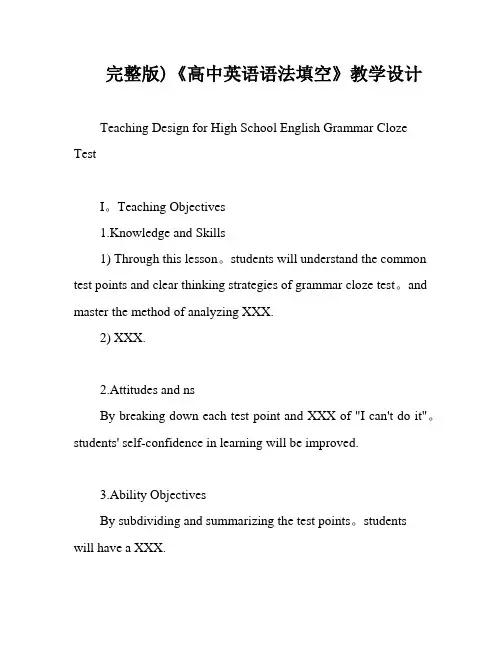
完整版)《高中英语语法填空》教学设计Teaching Design for High School English Grammar Cloze TestI。
Teaching Objectives1.Knowledge and Skills1) Through this lesson。
students will understand the common test points and clear thinking strategies of grammar cloze test。
and master the method of analyzing XXX.2) XXX.2.Attitudes and nsBy breaking down each test point and XXX of "I can't do it"。
students' self-confidence in learning will be improved.3.Ability ObjectivesBy subdividing and summarizing the test points。
studentswill have a XXX.II。
Key PointsUnderstand the common test points and thinking strategies of grammar cloze test。
and master the micro-XXX.III。
DifficultiesXXX.IV。
Student XXXXXX.V。
Teaching and Learning ProcessStep 1.Introduce XXX.Step 2.XXX.1.Pure cloze test2.Cloze test with given verbs3.Word n testStep 3.Introduce the method of grammar cloze test.1.XXX the part of XXX.2.Determine the part of XXX and grammar: articles。
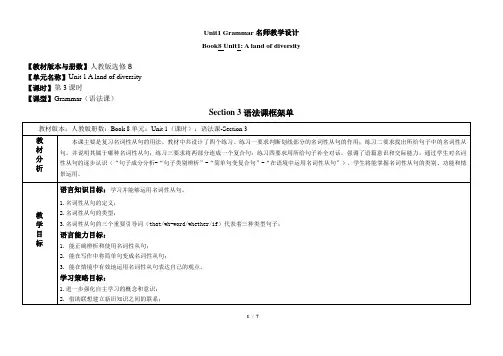


《高中英语语法填空》教学设计《高中英语语法填空》教学设计一、主题与目标本课程设计的主题是高中英语语法填空。
我们将通过讲解、演示和实践等方法,帮助学生掌握语法填空的基本技巧,提高他们在这一题型上的得分率。
二、教学内容我们将根据高考英语语法填空题型的特点,针对性地讲解以下知识点和技能:1、动词时态和语态2、主谓一致3、名词性从句4、定语从句5、状语从句6、强调句型7、倒装句8、虚拟语气三、教学方法我们将运用案例教学法、练习+讲解法和互动讨论法等多种方法,以激发学生的学习兴趣和主动性。
四、课堂实施1、第一阶段:导入新课。
通过展示一些语法填空的典型例题,引导学生思考解题的思路和方法。
2、第二阶段:知识点和技能讲解。
结合具体的例题,详细讲解上述八大语法知识点和技能,让学生深入理解语法填空的基本技巧。
3、第三阶段:实践练习。
设计一系列语法填空的练习题,让学生在实践中掌握所学知识和技能。
4、第四阶段:讨论与总结。
学生完成练习后,组织小组讨论,引导学生发现问题和不足,并及时给予指导。
最后,对本次课程进行总结,强调重点知识和技能。
五、教学评价我们将采用以下方式对学生的学习成果进行评估:1、课堂参与度:观察学生在课堂中的表现,如回答问题、参与讨论等,作为评价学生学习态度和参与度的依据。
2、练习完成情况:检查学生完成语法填空练习题的正确率,以此评估学生对所学知识和技能的掌握程度。
3、期末考试:通过期末考试的语法填空部分,检验学生在整个学期的学习成果。
六、反思与改进在课程结束后,我们将根据学生的反馈和评价结果,对本次课程进行反思和总结。
我们将关注学生的学习难点和需求,反思教学方法的有效性,并根据总结的结果对未来的教学进行改进。
为了提高教学效果,我们建议在每个教学阶段之后都进行及时的反馈和评估,以便及时发现并解决问题。
在课程设计过程中,也要充分考虑学生的实际需求和学习特点,以制定出更符合学生情况的教学计划。
总的来说,《高中英语语法填空》教学设计旨在帮助学生掌握英语语法填空的基本技巧,提高他们的解题能力。
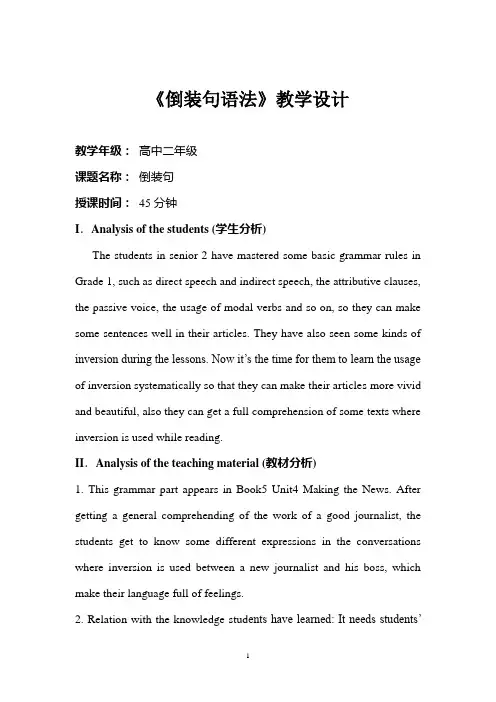
《倒装句语法》教学设计教学年级:高中二年级课题名称:倒装句授课时间:45分钟I.Analysis of the students (学生分析)The students in senior 2 have mastered some basic grammar rules in Grade 1, such as direct speech and indirect speech, the attributive clauses, the passive voice, the usage of modal verbs and so on, so they can make some sentences well in their articles. They have also seen some kinds of inversion during the lessons. Now it’s the time for them to learn the usage of inversion systematically so that they can make their articles more vivid and beautiful, also they can get a full comprehension of some texts where inversion is used while reading.II.Analysis of the teaching material (教材分析)1. This grammar part appears in Book5 Unit4 Making the News. After getting a general comprehending of the work of a good journalist, the students get to know some different expressions in the conversations where inversion is used between a new journalist and his boss, which make their language full of feelings.2. Relation with the knowledge stud ents have learned: It needs students’ability to analyze the meanings of the sentences according to the context, the structures of sentences and the agreement.3. Anticipation: By explaining important points often appear in reading texts and tested in exams, students can learn the methods to analyze the sentences including inversion structures well and solve the problems in “cloze text” and “filling in the blanks”, then improve their ability to use inversion in their own language.III.Teaching aims(教学目标)1. Target language(1) Let the students know how to analyze sentences containing inversion structures(2) Let the students master some important inversion structures whichare often used in sentences:Only after ... did sb. ...Only by doing ... could sb. ...Not only did ...Seldom have I ...2. Ability goalsEnable the students to use inverted sentences correctlyGuide the students to summarize the usage of Inversion3. Learning strategiesAsk the students mark out the sentences using inversion when readingor doing exercises, analyzing the structures and try to work out the meanings. And try to use this structure in their own articles and language.4. Affection and attitudesEnable the students to be careful and patient when analyzing inversion structures, considering the basic sentence pattern and the agreement.IV.Teaching strategies(教学策略)1. Teaching methods(1). Let the students find the sentences of Inversion in the reading passageand understand the meaning of them and conclude the two types of inversion(2). Explain important points often appear in reading texts or exams to help them know the rules.(3). Give the students some sentences or short passages to let them understand the rules better.(4). Task-based learning; cooperative learning; practice2. Teaching aidsA computer and a projector, related materials (self assessment)3. Materials prepared before classPrepare some sentences (some are often used in our text or reading materials, some are seen in the NMET exams from other parts in our country) and one or two short passages met in the “filling in theblanks” exercises.Use some pictures to arouse the students’ interests while giving examples and students practicing.V.Teaching procedures(教学过程)Step Ⅰ PresentationAsk the students to find the sentences of Inversion in the Reading. Then ask the students to think about some points:1. The difference between a inversion sentence and a sentence in normal order;2. How Inversion happens when different kinds of verbs are used, for example, link verbs and modal verbsStep Ⅱ Explanation and Summary1. The two types of inversion(1) Partly inversion(部分倒装):助动词/情态动词/系动词+主语+谓语动词e.g. Never have I heard such a thing.(2) Complete inversion(全部倒装): 谓语动词+主语e.g. Down fell the rain2. The situations where there is a need of inversion:1) Adverbial expressions of negation or near negation with no, not, never, neither, seldom, scarcely, rarely, barely and hardly, etc. (以否定词或半否定词开头的句子通常用部分倒装)e.g. In no case can an exception be made.Never have I seen such a stupid personI cannot attend the meeting tonight, and neither can my wife.The same reversal of word order takes place after negative conjunctions like neither…nor, not only ... but also, no sooner ... than.(此种情况同样适用于用否定连词开头的句子)e.g. Not until he loses all his money will he stop gambling.Scarcely had he entered the room when he was knocked down by a stranger.Not only is she beautiful, but she is also very intelligent.2) Adverbial expressions with only(Only + 副词/介词短语等状语/状语从句…放于句首时,常用部分倒装)e.g. Only after an operation will he be able to walk again.Only once has he done such a thing.3) Adverbial expressions with so(由so\such...that...引导的表示程度的状语从句,将其放于句首表示强调时,常用部分倒装)e.g. So greatly did he admire the beautiful actress he asked her to marry him.The word order is also reversed after the conjunction so.e.g. I caught a cold, and so did my wife.4) In the Conditions adverbial clauses led by if, when if is omitted. (在if 虚拟条件从句中,if省略时,had/ were/should等要与主语倒装)e.g. Should he be interested in this subject, he might work hard at it.= If he should be interested in this subject, he might work hard at it. 5) Adverbial expressions of place(以表示地点或时间的副词如here, there, now, then, thus等开头的句子常用全部倒装)e.g. There stood the tallest man he had ever seen.Inside the room were a few pieces of furniture.Now comes your turn..But when the subject is a pronoun instead of a noun, the order should not be inverted.e.g. Here he comes./ Off he ran.6) Other adverbials in initial position(用其他表方位的副词开头,谓语常用动词有come,go,rush,等不及物动词,也用全部倒装)e.g. Loud and clear rang the bells.Out rushed the students7) Some other situationsa.由as/though引导的让步状语从句中,其基本句式为:形容词/副词/名词+as/though+主语+谓语动词原形+as/though+主语+情态动词/助动词e.g. Child as/though he is, he knows a lot of English.=Although/Though he is a child, he knows a lot of English.Old as they were,… / Hard as he tried, … / Try as I might, …b.祝愿语e.g. May you succeed! / be happy!May peace return to the troubled land!Long live the People’s Republic of China!3. The Inversion structures often tested in NMET.1). 否定词位于句首时的倒装, hardly…when…等.2). so与neither, nor位于句首时的倒装时的含义.3). only位于句首时.4). as引导让步状语从句时的句子倒装。
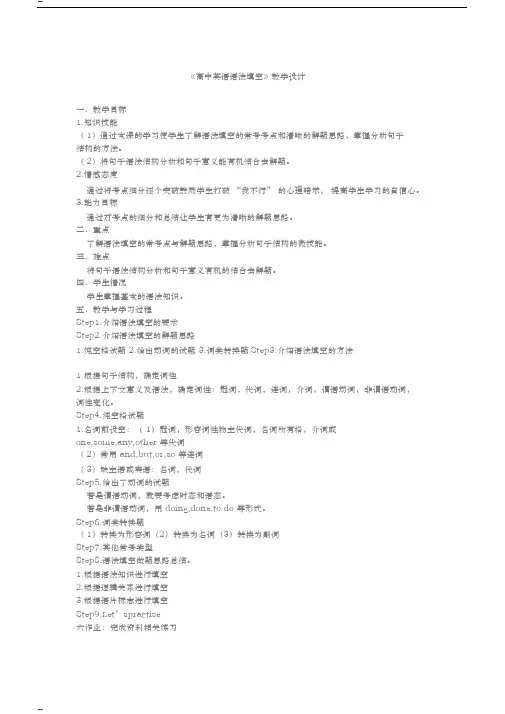
《高中英语语法填空》教学设计一.教学目标1.知识技能(1)通过本课的学习使学生了解语法填空的常考考点和清晰的解题思路,掌握分析句子结构的方法。
(2)将句子语法结构分析和句子意义能有机结合去解题。
2.情感态度通过将考点细分逐个突破鼓励学生打破“我不行” 的心理暗示,提高学生学习的自信心。
3.能力目标通过对考点的细分和总结让学生有更为清晰的解题思路。
二.重点了解语法填空的常考点与解题思路,掌握分析句子结构的微技能。
三.难点将句子语法结构分析和句子意义有机的结合去解题。
四.学生情况学生掌握基本的语法知识。
五.教学与学习过程Step1.介绍语法填空的要求Step2.介绍语法填空的解题思路1.纯空格试题2.给出动词的试题3.词类转换题Step3.介绍语法填空的方法1.根据句子结构,确定词性2.根据上下文意义及语法,确定词性:冠词,代词,连词,介词,谓语动词,非谓语动词,词性变化。
Step4.纯空格试题1.名词前设空:( 1)冠词,形容词性物主代词,名词所有格,介词或one,some,any,other 等代词(2)常用 and,but,or,so 等连词(3)缺主语或宾语:名词,代词Step5.给出了动词的试题若是谓语动词,就要考虑时态和语态。
若是非谓语动词,用 doing,done,to do 等形式。
Step6.词类转换题(1)转换为形容词(2)转换为名词(3)转换为副词Step7.其他常考类型Step8.语法填空做题思路总结。
1.根据语法知识进行填空2.根据逻辑关系进行填空3.根据语片标志进行填空Step9.Let’spractise六作业:完成资料相关练习七.教学反思。
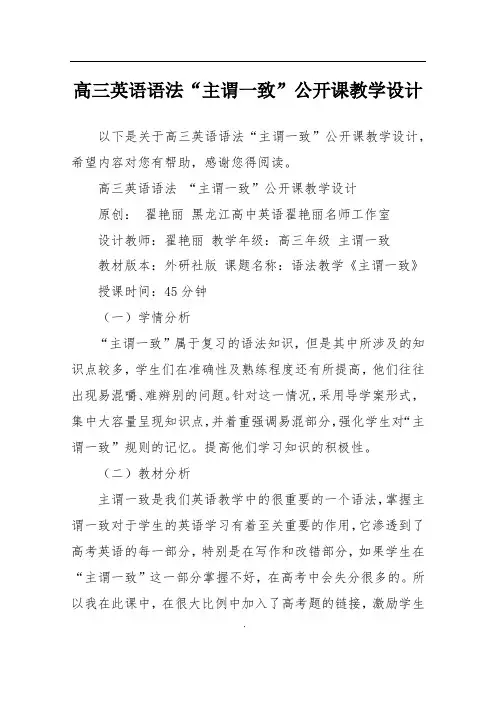
高三英语语法“主谓一致”公开课教学设计以下是关于高三英语语法“主谓一致”公开课教学设计,希望内容对您有帮助,感谢您得阅读。
高三英语语法“主谓一致”公开课教学设计原创:翟艳丽黑龙江高中英语翟艳丽名师工作室设计教师:翟艳丽教学年级:高三年级主谓一致教材版本:外研社版课题名称:语法教学《主谓一致》授课时间:45分钟(一)学情分析“主谓一致”属于复习的语法知识,但是其中所涉及的知识点较多,学生们在准确性及熟练程度还有所提高,他们往往出现易混嚼、难辨别的问题。
针对这一情况,采用导学案形式,集中大容量呈现知识点,并着重强调易混部分,强化学生对“主谓一致”规则的记忆。
提高他们学习知识的积极性。
(二)教材分析主谓一致是我们英语教学中的很重要的一个语法,掌握主谓一致对于学生的英语学习有着至关重要的作用,它渗透到了高考英语的每一部分,特别是在写作和改错部分,如果学生在“主谓一致”这一部分掌握不好,在高考中会失分很多的。
所以我在此课中,在很大比例中加入了高考题的链接,激励学生·认真仔细剖析高考题,以便于更好地理解把握“主谓一致”的规则和用法。
(三)教学目标新课标中明确指出:语法教学就是帮助学生提高语言实践活动中的能力。
本节课的教学目标为:激励学生将语法“主谓一致”真正落到实处,学会正确使用与主语一致的谓语动词。
(1)语言知识目标:准确记忆,灵活掌握“主谓一致”相应的规则。
(2)语言技能目标:培养学生在综合实践活动中对“主谓一致”语法规则的运用。
(3)情感态度目标:培养学生的自主学习能力以及合作探究能力。
(4)学习测略目标:主谓一致中的语法规则里需要揣测和理解的,所以这节课我着重帮助学生养成自主探究。
研究归纳语法规则的能力,促使他们保持课前预习,课上合作研究的良好学习习惯。
(四)教学重点、难点重点:①准确理解并掌握在同情况下谓语动词单复数的选择,全面记忆和使用主谓一致规则。
②在实际活动中,正确运用“主谓一致”原则。
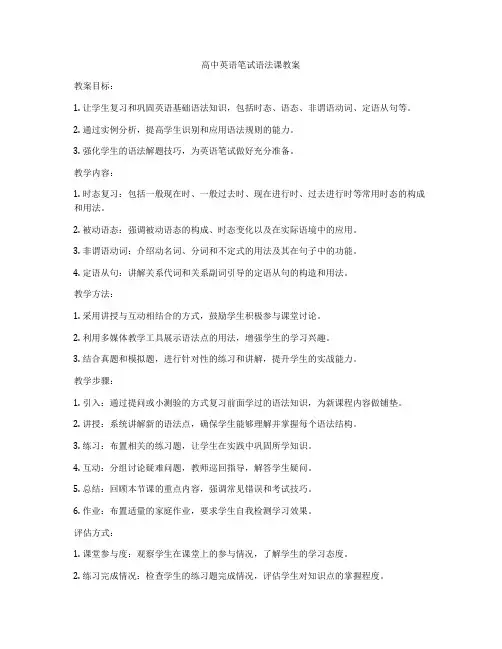
高中英语笔试语法课教案教案目标:1. 让学生复习和巩固英语基础语法知识,包括时态、语态、非谓语动词、定语从句等。
2. 通过实例分析,提高学生识别和应用语法规则的能力。
3. 强化学生的语法解题技巧,为英语笔试做好充分准备。
教学内容:1. 时态复习:包括一般现在时、一般过去时、现在进行时、过去进行时等常用时态的构成和用法。
2. 被动语态:强调被动语态的构成、时态变化以及在实际语境中的应用。
3. 非谓语动词:介绍动名词、分词和不定式的用法及其在句子中的功能。
4. 定语从句:讲解关系代词和关系副词引导的定语从句的构造和用法。
教学方法:1. 采用讲授与互动相结合的方式,鼓励学生积极参与课堂讨论。
2. 利用多媒体教学工具展示语法点的用法,增强学生的学习兴趣。
3. 结合真题和模拟题,进行针对性的练习和讲解,提升学生的实战能力。
教学步骤:1. 引入:通过提问或小测验的方式复习前面学过的语法知识,为新课程内容做铺垫。
2. 讲授:系统讲解新的语法点,确保学生能够理解并掌握每个语法结构。
3. 练习:布置相关的练习题,让学生在实践中巩固所学知识。
4. 互动:分组讨论疑难问题,教师巡回指导,解答学生疑问。
5. 总结:回顾本节课的重点内容,强调常见错误和考试技巧。
6. 作业:布置适量的家庭作业,要求学生自我检测学习效果。
评估方式:1. 课堂参与度:观察学生在课堂上的参与情况,了解学生的学习态度。
2. 练习完成情况:检查学生的练习题完成情况,评估学生对知识点的掌握程度。
3. 家庭作业:批改家庭作业,及时发现并纠正学生的错误。
4. 定期测试:通过定期的小测试来检验学生的学习效果和进步。
总结:。

英语句法教学设计备课时间:2023年9月27日Exercise September 27, 2023一、给故事补充状语。
We met .(地点状语和时间状语)We liked each other .(原因状语)I taught you English ,(目的状语)you make me happy .(方式状语)we are friends .(让步状语)二、划出主语和宾语,分析词性,总结用法。
Jim wanted a car. Buying a car needs 100 thousand, so he couldn't afford to buy a car. I don’t know how to help him. What I could do is to lend him money.We enjoyed driving car around the city. To compete with carsaround is so interesting.小结:可以做主语或宾语,用来充当主语的句子是用来充当宾语的句子是。
三、找谓语,析词性We are students.We can speak English well. Our pronunciation sounds great. I hope my English become better and better. We keep quiet to study everyday.小结:除了可以做谓语,也能构成谓语.四、找表语,析词性The man is a basketball player, Who is handsome and number one.These balls are his, which are behind you. His argument about basketball sounds convincing. He seems well qualified for the job. His dream is to win 100 gold medals.His greatest virtue is that He will never stop fighting. His game will never be over.小结:除了不可以,可以做表语,用来充当表语的句子叫做。
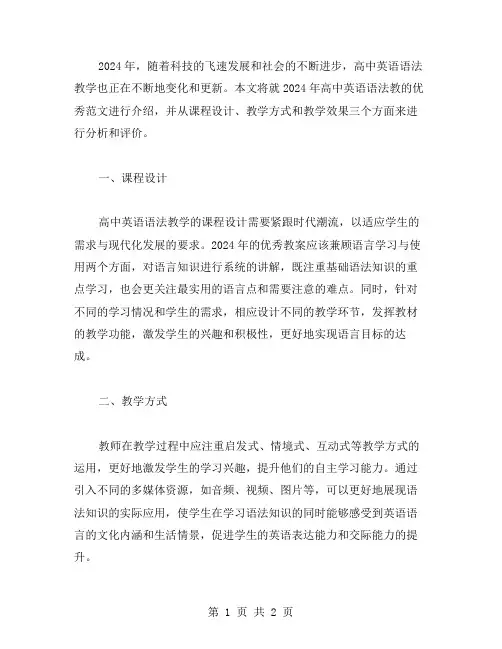
2024年,随着科技的飞速发展和社会的不断进步,高中英语语法教学也正在不断地变化和更新。
本文将就2024年高中英语语法教的优秀范文进行介绍,并从课程设计、教学方式和教学效果三个方面来进行分析和评价。
一、课程设计高中英语语法教学的课程设计需要紧跟时代潮流,以适应学生的需求与现代化发展的要求。
2024年的优秀教案应该兼顾语言学习与使用两个方面,对语言知识进行系统的讲解,既注重基础语法知识的重点学习,也会更关注最实用的语言点和需要注意的难点。
同时,针对不同的学习情况和学生的需求,相应设计不同的教学环节,发挥教材的教学功能,激发学生的兴趣和积极性,更好地实现语言目标的达成。
二、教学方式教师在教学过程中应注重启发式、情境式、互动式等教学方式的运用,更好地激发学生的学习兴趣,提升他们的自主学习能力。
通过引入不同的多媒体资源,如音频、视频、图片等,可以更好地展现语法知识的实际应用,使学生在学习语法知识的同时能够感受到英语语言的文化内涵和生活情景,促进学生的英语表达能力和交际能力的提升。
三、教学效果一个优秀的语法教案不仅需要在课程设计和教学方式方面有所突破,更关键的是需要取得好的教学效果。
教学过程中应该关注学生的表现和反馈,寻求他们的意见和建议,优化教学环节和方法。
教师应该注重补充和更新教学内容,随时跟进教学进度和学生的学习情况,及时调整教学任务和找到合适的教学方法。
只有通过好的教学效果,才能真正证明教案设计、教学方法等各方面的优秀性。
2024年优秀的高中英语语法教案需要在课程设计、教学方式和教学效果方面得到全面的发挥。
它应该兼顾语言学习与应用,更注重寓教于乐和互动式的教学方式,积极追踪学生的学习情况和反馈,实现良好的教学效果。
同时,教师应该做到不断学习,不断调整自己的教学方法和内容,不断创新和优化,为学生提供更好的语言学习环境和服务,为培养具有国际视野、跨文化交流能力的英语人才做出应有的贡献。
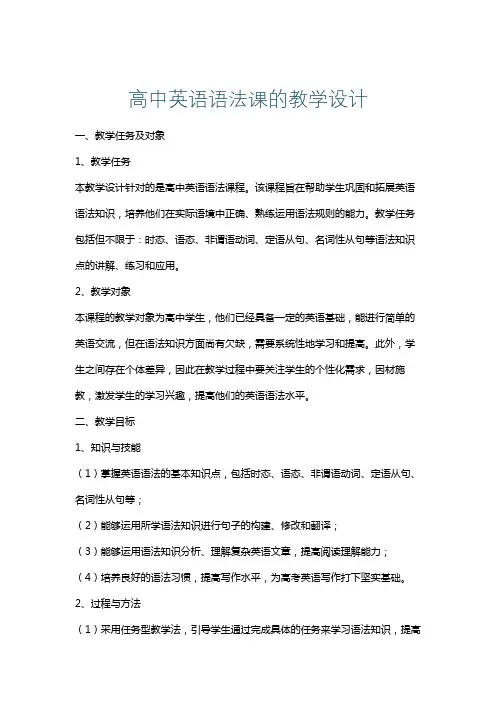
高中英语语法课的教学设计一、教学任务及对象1、教学任务本教学设计针对的是高中英语语法课程。
该课程旨在帮助学生巩固和拓展英语语法知识,培养他们在实际语境中正确、熟练运用语法规则的能力。
教学任务包括但不限于:时态、语态、非谓语动词、定语从句、名词性从句等语法知识点的讲解、练习和应用。
2、教学对象本课程的教学对象为高中学生,他们已经具备一定的英语基础,能进行简单的英语交流,但在语法知识方面尚有欠缺,需要系统性地学习和提高。
此外,学生之间存在个体差异,因此在教学过程中要关注学生的个性化需求,因材施教,激发学生的学习兴趣,提高他们的英语语法水平。
二、教学目标1、知识与技能(1)掌握英语语法的基本知识点,包括时态、语态、非谓语动词、定语从句、名词性从句等;(2)能够运用所学语法知识进行句子的构建、修改和翻译;(3)能够运用语法知识分析、理解复杂英语文章,提高阅读理解能力;(4)培养良好的语法习惯,提高写作水平,为高考英语写作打下坚实基础。
2、过程与方法(1)采用任务型教学法,引导学生通过完成具体的任务来学习语法知识,提高实际应用能力;(2)运用情景教学法,创设丰富的语言环境,让学生在真实语境中感知、体验和运用语法知识;(3)采用启发式教学法,引导学生主动思考、发现和总结语法规律,培养学生的自主学习能力;(4)通过小组合作、讨论、展示等形式,促进学生之间的交流与互动,培养学生的团队合作精神和沟通能力。
3、情感,态度与价值观(1)培养学生对英语学习的兴趣和热情,使他们能够积极主动地投入到语法学习中;(2)引导学生树立正确的语法学习观念,认识到语法学习对提高英语水平的重要性;(3)培养学生的耐心、细心和毅力,使他们能够在面对语法学习中的困难时,保持积极的心态,勇于克服;(4)通过语法学习,帮助学生提高跨文化交际能力,增进对英语国家文化的了解和尊重,培养国际化视野;(5)培养学生良好的学习习惯和道德品质,如诚信、勤奋、合作等,使他们在学习过程中形成正确的价值观。
高中语法课教案【篇一:高中英语语法课教学设计】篇一:高中英语语法课教学活动的设计高中英语语法课教学活动的设计密云县第二中学季李红【摘要】本文结合三个课例,探讨了高中英语语法课教学活动设计可遵循的原则,以实现学生在课堂中的主体地位,发展思维能力,促进综合语言运用能力的形成。
【主题词】语法教学活动设计主体地位笔者以课例研究的方式对语法教学进行了大量实践,认为语法课教学活动的设计应注意以下原则。
一、教学活动的设计与教学目标一致教学活动的设计要与教学目标一致,为教学目标达成服务,因此每个教学活动要有明确的目的。
以北师大版第五模块第13单元语法项目---情态动词表推测,语言鲜活。
为了实现教学的第一个目标,笔者对教材设计的教学练习做了如下调推测的句子,没有足够调动学生的主动性,激发他们的思维活动;事实上,要学生关注目标语法结构前,教师应对语料进行必要的阅读理解处理,这有利于解决教学难点。
此外,文中有18个含情态动词的句子;其中4个不是情态动词表推测的句子。
若学生能将他们成功挑出,说明他们不但回顾了旧知识,理解了must, may, may not, might, can’t, could 表推测时,在上下文中表达的语气,而且更将注意力关注于目标语法。
本课的教学难点为:use the proper forms of modal verbs to express guesses about what happened and what is happening now. 为了在教学中突破难点,笔者将测的深层含义,同时又关注、归纳出了语法规则。
在归纳法语法教学模式中,学生首先接触的是包含语法规则的真实上下文情景,然后根据上下文的信息归纳出使用规则。
这种教学法有助于培养学生的语感。
通过分析归纳总结语言使用规律课深化学生对用法的理解,培养学生的逻辑思维能力。
但教师必须提供充足的,以语境为依托的语料,教学活动的形式适合学生的认知水平,他们的观察、体验、探究、合作等主动学习行为才得以开展。
必修第一册Unit1 Life Choices
教学设计
【教材分析】
本节课是北师大版高中英语必修1Unit1 Life choices Lesson1 Lifestyle 第二课时的教学设计,课型是语法课。
通过本节课的学习,提高学生在阅读理解的长难句分析的能力,同时也有效的提高学生的改错能力和英语写作水平。
【教学目标与核心素养】
(1).学生能够辨析句子中的谓语动词与非谓语动词。
(2).学生能够分析,识别非谓语动词在句子中充当的成分。
学生能够在句子当中正确使用非谓语动。
词。
让学生通过在文章中的故事语境中感知谓语动词与非谓语动词的差异性。
让学生在语境中体会语言的学习应用,从而给学生树立正确的语言学习观。
【教学重难点】
1.重点
(1)辨析句子中的谓语动词和非谓语动词;
(2)识别非谓语动词在句子中充当的成分。
2.难点
能正确识别并使用非谓语动词。
【教学过程】。
高中英语语法课教案全英文篇一:高中英语语法课的教学设计人教版高中英语选修7 Unit4语法教学设计The Revision of Attributive Clauses ( I )高州市第一中学梁智群一、教材依据人教版高二教材选修7第四单元Revising useful structures部分的内容为the revision of the restributive attributive clauses。
二、教学目标根据《新课程标准》关于总目标的具体描述,结合高二学生实际和教材内容,制定相应教学目标:(一)知识与能力1、复习、理解、巩固限制性定语从句的结构及其用法;2、在真实的语境和任务完成中复习、理解、巩固限制性定语从句的结构及其用法;3、提高学生用英语获取信息、处理信息、分析和解决问题的能力,逐步培养学生用英语进行思维和表达的能力;4、培养学生自主学习、合作学习的能力。
(二)过程与方法1、采用“任务型”语言教学。
根据不同的语法内容设计不同的任务,让学生通过完成任务,在语言运用中去学习、掌握语言形式和语言规则,使学生在做中学,在做中练,在做中巩固。
2、利用真实的环境或设计模拟的情境进行语法教学,使语法教学更趋形象化、直观化、真实化和趣味化。
情景活动中的学习降低了语法学习的难度,激发了学生学习英语的积极性,使他们学得快,记得牢,用得活。
3、把某些语法教学转化为交际活动,具体设计有:(1)英文歌式通过画出英文歌中的restributive attributive clauses,使教学内容生动形象,不仅调动学生的学习兴趣,而且营造良好的课堂氛围。
(2)游戏式根据教学内容设计“接龙”游戏及猜谜游戏。
在这样的操练活动中,学生既锻炼了思维能力与快速反应能力,又加深了对所学语法现象的理解,同时使语法教学既轻松又有效。
(3)讨论式设计一些练习,让学生与同桌或小组同学相互讨论学习,激发学生学习的兴趣,增强学生对英语语言信息的使用和接受能力。
英语语法复习教学设计英语语法复习教学设计范文(一)教学内容与目标教学内容:复习高二英语unit 14 Freedom fighters教学内容分析:本次复习课的开展围绕着自由民主战士话题展开,在引导学生复述马丁路德金的故事的过程中,帮助学生们回忆课本中涵盖的重点词汇和句型。
这个过程以师生间的问答形式展开,以学生针对不同要求的口头回答为主,在复习教材内容的同时,巩固高二所掌握的词句和语法。
除此之外,学生要求将所复习到得词汇、句型用于自己的再创造,写出一篇字数100字左右的命题作文。
学生分析:处于高三第一轮复习阶段的学生通常不愿意开口说英语,因此通过故事性的串联更容易能够调动学生,从而全面地训练他们的英语应用能力。
语言知识目标:1.词汇:treat,slavery,separation,segregation,forbid,vote,discriminate,join hands,be subject to,etc.2. 句子结构:Winning the scholarship gave him the chance to go to college.There was a time when blacks were not recognized as full citizens.What all these groups have in common is that they ask to be treated with respect.能力目标:1.能运用本单元的重点词汇复述马丁路德金的故事和相关信息2.能在写作中灵活地运用所复习的句子结构情感态度目标:通过复习高二的第十四单元,加强学生对于平等的意识,坚定信念,勇于迎接挑战。
(二)教学过程与方法以任务型教学为主,课堂上通过任务型教学活动的设计,组织个人、双人、小组、全班等活动,让学生积极参与;通过问题的设置,引导学生进行思考,勇于表达自己的思想。
《高中英语(上外版)》必修第三册Unit 1 Road to Success课时:第3课时课题:Grammar in Use课型:语法课教学设计与说明一.学情分析本节课授课对象为高一第二学期的学生。
经过第一学期的学习,同学们已经有了分词在句子中各项功能的总体概念。
但是大部分同学们对分词各项句法功能的总体框架结构是不清晰的,对分词的各项句法功能各自的特点、重点、难点没有概念。
所以需要帮助学生分项理清特点、重点、难点,并在语言实际交际运用中加以操练并巩固。
二.教材分析单元语法运用Grammar in Use聚焦于分词作补语(宾语补足语和主语补足语)的复习和巩固。
教材P9-10上有三道语法练习题。
第一题旨在分析分词在句子中的功能,认识分词做补语的结构。
第二题旨在辨认分词作补语的结构并能正确区分这一结构中现在分词和过去分词在做补语时的区别。
第三题考查语言的综合运用能力,要求学生在语篇中、在上下文语境中理解、分析、归纳并灵活运用分词作补语这一语法功能,同时要求学生区分分词作补语与分词其它功能的区别。
三.教学设计思路本课为本单元语法教学的第二课时:语法练习课,旨在帮助学生在第一节语法课的基础上复习巩固分词作补语这一语法功能,并为学生创设产出的机会,提高语用能力。
导入部分利用课本P8-9练习I&II,采用归纳演绎教学法复习第一课时学习过的内容,引导学生学会对学过的语法规则进行分类归纳,在头脑中形成非谓语知识体系的网络架构。
操练部分采用任务型教学方法,在遵循学生认知规律的基础上设置多层次能力要求逐步递进的实践任务,引导学生在完成各个层次的任务中逐步实现分词做补语这一语法功能的内化,并在任务中实现learning by using, learning for using的语法学习目标。
Lesson Plan(the 3 period)rdLearning Objectives:By the end of the period, the students are expected to:1. have the ability of classifying and summarizing grammar rules of -ing / -ed forms as complements;2. form the network of -ing / -ed forms as complements in mind so as to distinguish them from other functions of -ing / -ed forms;3. skillfully apply -ing / -ed forms as complements in listening, reading and writing.Learning Procedures:Step I. Revision (Interactive activity)*T: Help the students recall and classify what they learned in the first period of Grammar in Use with the help of Exercise I & II on P 8-9.*Ss: Recall the grammatical rules of -ing / -ed forms used as complements by category.I. -ing form used as complements:feel / hear / listen to / see / watch / look at / notice / observe ... + O. + doing (O. C.)S.+ be felt / heard ... + doing (S. C.)discover / find / smell / catch ... + O. doing (O. C.)S. + be + discovered ... + doing (S. C.)get / have / keep / leave / send / set / start ... + O. doing (O. C.)with + O. + doing (O. C.)II. -ed form used as complements:see / hear / watch / find / feel / consider ...+ O. + done (O. C.)S.+ be seen ... + done (S. C.)get / have / keep / leave / make ... + O. + done (O. C.)declare / like / need / order / want / wish ... + O. + done (O. C.)with + O. + done (O. C.)Note: After working non-stop for twenty hours, he went to bed tired and hungry. (O. C.) The athlete went away quite satisfied with the result of the match. (O.C.)Step II. PracticeI. Identify - ing /- ed forms as complements in the lyrics (Task 1)*T: Play the song “Those Sweet Words” and ask students to identify - ing /- ed forms as complements in the lyrics while enjoying the melody. And then focus on the functions of -ing / -ed forms in “Iknow I saw you saying it.” and “I just h ave to hear t hose sweet words s poken like a melody.” and the meanings of the two sentences.*Ss: Identify - ing /- ed forms as complements and translate the two sentences into Chinese.Those Sweet WordsBy Norah JonesWhat did you sayI know I saw you saying itMy ears won't stop ringingLong enough to hearThose sweet wordsWhat did you sayAnd now the dayThe hour hand has spunBefore the night is doneI just have to hearThose sweet wordsSpoken like a melodyAll your love...II. Apply -ing / -ed forms as complements in individual sentences. (Task 2)*T: Ask students to identify the structure of -ing / -ed forms as complements in the following sentences and then fill in the blanks with proper forms of the verbs given in the box. Call students’attention to the differences between -ing forms as complements and -ed forms as complements.*S: Read the sentences silently and underline the structure of -ing / -ed forms as complements in each sentence and then fill in the blanks with -ing forms or -ed forms based on grammar rules of the differences between -ing forms as complements and -ed forms as complements.III. Apply -ing / -ed forms as complements in a passage. (Task 3)*T: Ask students to read a short passage and fill in the blanks with the -ing / -ed forms of the verbs given in the box. Then circle the ones that are used as complements. Call students’ attention to the differences between -ing / -ed forms as complements and -ing / -ed forms for other functions.*S: Read the short passage silently and circle the structures of -ing / -ed forms as complements in the passage and then fill in the blanks with -ing forms or -ed forms based on grammar rules of the differences between -ing / -ed forms as complements and -ing / -ed forms for other functions.IV. Apply -ing / -ed forms as complements in writing sentences. (Task 4)*T: Ask students to read each sentence in Chinese carefully and make out which category of -ing / -ed forms as complements fits the contexts best based on the given word in the brackets. And then translate the whole sentence into English.*S: First, make out and write down the proper structure of -ing / -ed forms as complements. Then, translate the whole sentence into English.。
高中英语语法形容词和副词教案一、教学目标1. 让学生掌握形容词和副词的基本概念及其用法。
2. 培养学生正确运用形容词和副词修饰名词和动词的能力。
3. 提高学生英语写作和口语表达的准确性和丰富性。
二、教学内容1. 形容词和副词的定义及其作用。
2. 形容词和副词的词性和变化。
3. 形容词和副词的比较级和最高级。
4. 形容词和副词的常见搭配。
5. 形容词和副词在句子中的位置和用法。
三、教学重点与难点1. 形容词和副词的词性和变化。
2. 形容词和副词的比较级和最高级。
3. 形容词和副词的常见搭配。
4. 形容词和副词在句子中的位置和用法。
四、教学方法1. 采用情境教学法,通过实物、图片、例句等方式引导学生理解形容词和副词的用法。
2. 运用任务型教学法,让学生在实际操作中练习运用形容词和副词。
3. 采用分组讨论法,鼓励学生相互交流、合作,提高语言实践能力。
五、教学步骤1. 导入:通过展示图片或实物,引导学生说出相关的形容词和副词,引出本课主题。
2. 讲解:讲解形容词和副词的定义、词性、变化、搭配及在句子中的位置和用法。
3. 练习:设计不同类型的练习题,让学生巩固所学知识。
4. 拓展:介绍形容词和副词的常见搭配,并举例说明。
6. 作业:布置相关的练习题,让学生课后巩固。
六、教学活动1. 设计形容词和副词的寻找游戏,让学生在图片或句子中找出形容词和副词。
2. 进行小组竞赛,看哪个小组能正确使用形容词和副词完成句子。
3. 角色扮演:学生分组扮演不同角色,使用形容词和副词描述角色特征或环境。
七、课堂互动1. 提问:让学生回答关于形容词和副词的问题,如定义、用法等。
2. 讨论:分组讨论形容词和副词的搭配,分享彼此的发现。
3. 问答:学生相互提问,用形容词和副词描述对方的特点。
八、课堂实践1. 写作练习:让学生写一篇短文,用形容词和副词描述一个事物或人物。
2. 口语表达:让学生用形容词和副词描述自己的日常生活或经历。
3. 听力练习:播放含有形容词和副词的对话或短文,让学生回答相关问题。